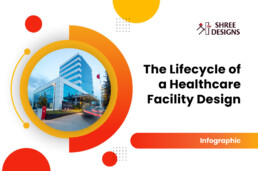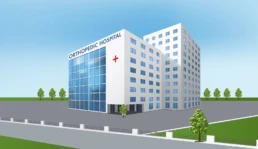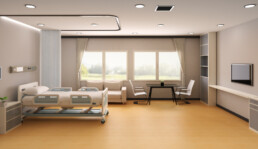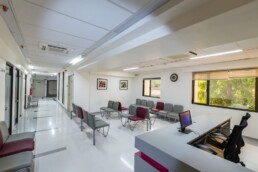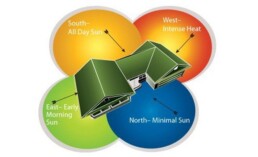A vital piece of the puzzle is now gaining the attention it deserves! Over the years, we have realised that one of the key factors in improving patient experiences and outcomes lies in the planning and design of the building and spaces where they are treated. The size and layout of a healthcare facility, placement of wards, the environment in waiting rooms and ease of accessibility and navigation all play an important role in the healing experience.
Design makes a significant impact on the delivery of care for both healthcare providers and patients. This is why architects and healthcare organizations are coming together to incorporate essential design elements when building their facilities.
Here are 5 essential elements of healthcare design that bring great results!
1 Patient-centric design
When we design any facility, we look at the patient’s journey as they experience each touchpoint at the hospital or clinic. At the same time, we must look at creating efficient workflows for the clinical staff as they look after their patients.
Design has a direct impact on how patients, relatives and caregivers feel. When implemented well, the combined effect of clean and sterile areas, the right colours, and easy wayfinding can come together with technology, services and resources to deliver a mutually beneficial, memorable experience in any healthcare facility.
So how do we balance functional and soothing designs when creating healing spaces? Kshititi Nagarkar, Shree Designs, says,
“The starting point for us is the proper juxtaposition of healthcare spaces, in terms of function, to achieve operational efficiencies. I believe that we need to design these spaces to be less intimidating and more humane and should support quicker healing.
We ardently follow the principles of ‘Patient Centred Care’ to keep the patient in focus within and outside of the facility. ‘Patient Privacy’, ‘Design for Positive Distraction’, and ‘Themed Interiors and Concepts’ are a few other principles we employ to engage the patients’ minds.”
2 Favour Flexibility
The medical industry is constantly evolving, which means healthcare facilities have to be flexible to change as well. When creating designs for healing spaces, we can leave room to upgrade, renovate and retrofit different aspects in the future so that the facility can keep up with changing clinical technology, industry trends or healthcare standards.
After all, equipment dictates design, design does not dictate equipment.
Our previous blogs on adaptive reuse of existing spaces and retrofitting for healthcare facilities speak about these factors in detail.
“Flexibility is one of the guiding principles to promote healing by giving new approaches to care and innovation through the adaptive use of space,’ says Annie Coull, Vice President of Stantec.
Our design teams work with owners and healthcare organizations to create plans that are responsive to change. When designing for flexibility, we need to design systems and spaces so that they can easily facilitate expansion if and when needed.
We can adopt a modular mentality, where we think about not only the current function of a space but also plan for multiple purposes in the future. For example, if the right infrastructure is kept in place, a patient’s room can be upgraded into an intensive care bed or downgraded to an examination room if required.
3 Switch to Sustainable
In healthcare, sustainability provides patients and providers with durable, sterile environments.
As a practice, hospital floors and surfaces are exposed to frequent cleaning with harsh chemicals. So, we need materials that are resilient enough to withstand these factors and that won’t easily deteriorate or crack or break so that we can clean them appropriately.
Hospitals are also high-traffic areas with increased movement, especially during emergencies. We need strong and durable surfaces to face these harsh conditions.
“From a sustainability standpoint, they have an interior solution that becomes something they can use for the next 50 years. It doesn’t have to get torn out because it’s not working for them anymore.” Kristin Moore, Director of Healthcare for DIRTT Environmental Solutions, Calgary, Alberta
For more details, our previous blogs describe how you can keep your healthcare facility safe, sterile and sustainable.
4 Air quality and ventilation
The effect of natural light and fresh air are often overlooked but play a vital role in creating healing spaces. Ventilation and daylight are known to decrease recovery times and improve patients’ mental health while boosting productivity in care providers.
Air control, filtration and ventilation technologies, including the heating, ventilation and air conditioning (HVAC) systems, can really optimize the environments at healthcare facilities. It is essential to implement filtration systems that match the layout, clinical goals and infection control policies of the healthcare organization.
High-Efficiency Particulate Air (HEPA) filters, fixed into the HVAC systems, are often used in special-care areas. Air from airborne infection isolation rooms should be exhausted directly to the outside or be filtered through a HEPA filter to prevent contamination of the other areas in the hospital.
5 Right-sizing in healthcare facilities
Sizing is a critical principle when it comes to creating a functional design for healthcare facilities. Healthcare administrators and architects are keenly aware of every square foot in a new building and in renovation projects. The idea is to maximize the utility of a given area while optimising operations to increase patient satisfaction and improve outcomes. With rightsizing, we also provide the flexibility needed for future changes.
In the world of healthcare, failure to plan is planning to fail!
We need robust, streamlined and well-planned designs for healthcare facilities in order to use them to their fullest potential. At Shree Designs, we help to create healthcare infrastructures which support effective communication, collaboration and precision in the complex, changing world of healthcare.
Find out more about our projects by clicking here: https://www.shreedesigns.in/projects/
Related Posts
Designing Healthcare Facilities
Textures in Healthcare Spaces
When designing hospitals or clinics, texture is often seen as a “finishing touch.” At Shree…
Designing Healthcare Facilities,Infographic
The Lifecycle of a Healthcare Facility Design
Ever wondered what goes into designing a hospital or clinic that actually works - clinically,…
Designing Healthcare Facilities
Designing NABH-Compliant Hospital Interiors
A well-designed hospital isn’t just about aesthetics. From fire safety and infection control to…
Designing Healthcare Facilities,Infographic
Blueprint for Healthcare Design
From room dimensions to lighting levels, every detail matters in healthcare design. At Shree…
Designing Healthcare Facilities
Building Better Day Surgery Centres
Efficient care, happier patients, and smarter workflows - this is what defines a successful…
Designing Healthcare Facilities,Infographic,Project Management
Designing Healthcare Spaces That Truly Heal
From concept to completion, every medical space we design prioritizes patient flow, staff…
Designing Healthcare Facilities
The Business of Wellness
In the $1.8 trillion wellness industry, first impressions matter. Patients don’t just choose a…
Designing Healthcare Facilities
Efficient Hospital and Clinic Design
India’s emerging cities are growing rapidly, creating an urgent demand for accessible and efficient…
Designing Healthcare Facilities
Creating Calming and Confidential Spaces for Fertility Clinics
As the demand for fertility treatments grows, the architecture of these clinics plays a vital role…
Designing Healthcare Facilities
Designing the Perfect Hospital Pharmacy
Hospital pharmacies are the backbone of seamless patient care. From efficient workflows to secure…
Designing Healthcare Facilities
Preventive Care Facility Design Strategies
With preventive care emerging as the future of healthcare, this post outlines key architectural…
Designing Healthcare Facilities
Thermal Comfort Decoded
Thermal comfort plays a critical role in patient recovery, staff productivity, and overall…
Designing Healthcare Facilities
Building for Tomorrow: The Imperative of Adaptable Healthcare Design
Healthcare facilities need to be as dynamic as the industry itself. Traditional, rigid designs can…
Designing Healthcare Facilities
Designing Single Speciality Healthcare Centres
As single-speciality centres grow, their design needs become more specific, calling for tailored…
Designing Healthcare Facilities
Innovative Design Solutions for Senior Care Facilities
Designing senior-friendly spaces in healthcare facilities is crucial for catering to the evolving…
Designing Healthcare Facilities
Designing a Dental Clinic for Success
Providing quality dental care is not just about the technical elements of the treatment. It's also…
Designing Healthcare Facilities
3 Essential Design Features for Intensive Care Units
ICUs are not just limited to single units housing all critical patients. If the facility has…
Designing Healthcare Facilities
3 Lessons Learned While Building a Cardiac Cath Lab
Cardiac care design is moving at the sound of a new beat! The number of Cath labs in India has…
Designing Healthcare Facilities
5 Best Ways to Create Healing Spaces for Kids
Designing spaces in healthcare facilities tailor-made for children is a lesson in balance! A…
Designing Healthcare Facilities
Top 5 Trends in Healthcare Design
Design can make all the difference when it comes to improving patient care. From a patient’s point…
Designing Healthcare Facilities
The Architectural Design of Hospital Facilities
Shree Designs designed and executed many efficient and safe healthcare setups in the middle of the…
Designing Healthcare Facilities
Dauntless Designers
Healthcare Radius in its 7th Anniversary Special issue in October 2019, featured a "power list of…
Designing Healthcare Facilities
The changing face of healthcare design
After completing a decade in designing healthcare projects, Kshititi Nagarkar, principal architect,…
Designing Healthcare Facilities
Thumb Rules for Planning and Designing of Hospitals
Traditional rules of thumb in healthcare planning have changed. Once-accepted rules can now be the…

